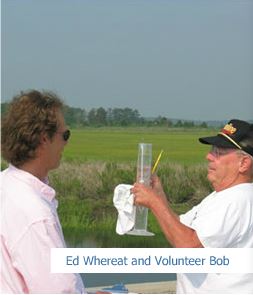Citizen Monitoring Program
2009 WATER QUALITY REPORTS AND SUMMARIES
Download and view our poster gallery below.
Aug 19 - Sept 10
Here is the seventh set of Citizen Monitoring Program Reports for 2009, covering the period August 19 to September 10.
- The weather has been variable, but generally cool, and windy and wet. It seems like an early end to summer.
- Although there has been recent improvement in DO conditions at some sites, moderately low dissolved oxygen conditions (<4.0 ppm) persisted in many locations, and severely low conditions (< 2.0 ppm) were mostly restricted to canal systems.
- Major accumulations of submerged vascular plants and algae persisted in Diamond Pond, and some estuary sites had minor accumulations of seaweeds.
- Total Enterococcus bacteria levels were elevated in a number of locations including two streams in the Broadkill watershed, select tributaries of all estuaries, and a few bayshore sites.
- Although the HAB flora was diverse, only modest blooms were found in a few canals, tributaries and ponds. Background levels of Karenia papilionacea persisted at the ocean beaches.
Aug 6 - 20
Here is the sixth set of Citizen Monitoring Program Reports for 2009, covering the period August 6 to August 20. Sorry, but we missed distribution on Fri the 21st.
- The weather has been warm and humid with frequent scattered thunderstorms, so pretty normal for August.
- As before, moderately low dissolved oxygen values (<4.0 ppm) were observed in many locations, but severely low conditions (< 2.0 ppm) were restricted to a few canals and in Old Mill Creek.
- The ponds in Milton (Diamond and Wagamons) had major accumulations of submerged vascular plants and algae. Some estuary sites in the Inland Bays had minor accumulations of seaweeds.
- Total Enterococcus bacteria levels were generally reduced, with a few exceptions including Warwick Cove (upper Indian River Bay), Fenwick Island (Little Assawoman Bay), and Ingram Ditch (stream in Broadkill watershed)
- Things remained relatively quiet on the HAB front. There were a few moderately dense blooms of Gyrodinium instriatum (non-toxic) in 2 tributaries and 1 canal, and a moderate bloom of Fibrocapsa japonica (potentially toxic) in the Loop Canal terminus in Bethany. Karenia papilionacaea was detected at background concentrations at the Indian River Inlet at about the same time as last year. This is the non-toxic, or at least much less toxic, relative of Karenia brevis (a.k.a. FL Red Tide).
July 32 - Aug 6
Here is the fifth set of Citizen Monitoring Program Reports for 2009, covering the period July 23 to August 6.
- In general, temperatures have been about average, but rainfall has been well above normal.
- Although there was some improvement, low dissolved oxygen values (< 4.0 ppm) remained widespread, and severely low values (<2.0 ppm) remained restricted to a few locations including Old Mill Creek and a few canal systems.
- Accumulations of Nuisance Aquatic Vegetation were observed in a few more locations, although most were minor. Major accumulations were noted in Diamond Pond, the Primehook boat ramp, and the Salt Pond.
- Total Enterococcus bacteria levels were somewhat elevated again in many locations.
- Harmful algae bloom species continue to be widespread in the estuaries, but cell densities have generally been low. Ocean and Inlet samples have been free of Karenia (FL Red Tide). Silver Lake, Rehoboth had a bloom of potentially toxic Blue-green algae, while Lake Gerar had a bloom of non-toxic Green Algae.
July 8 - 23
Here is the fourth set of Citizen Monitoring Program Reports for 2009, covering the period July 8 to July 23.
- In spite of a few warm days last week, it has remained rather cool. In the last few days, moderate rainfall has eased a three-week dry spell.
- Low dissolved oxygen values (< 4.0 ppm) remained widespread, and severely low values (<2.0 ppm) remained restricted to a few locations including Old Mill Creek and a few canal systems.
- Minor accumulations of Nuisance Aquatic Vegetation were observed in a few locations. Major accumulations remain in Diamond Pond.
- Total Enterococcus bacteria levels were lower at most sites in the Inland Bays, but were elevated in some sites in the Broadkill watershed, including both fresh water and estuary sites.
- Harmful algae bloom species continue to be widespread in the estuaries, but cell densities have generally been low, except for a few blooms of non-toxic species. There have been no signs of the Florida Red Tide (Karenia) in the ocean or inlets so far this year.
June 17 - July 8
Here is the third set of Citizen Monitoring Program Reports for 2009, covering the period June 17 to July 8.
- The wet weather has subsided, but it has remained relatively cool and breezy, and tides have been running higher than normal.
- Low dissolved oxygen readings (<4.0 ppm) have been widespread but intermittent. Severely low readings (<2.0 ppm) were consistently found in Old Mill Creek, downstream of Red Mill Pond.
- Accumulations of Nuisance Aquatic Vegetation were less widespread, but persist in a few locations.
- Total Enterococcus bacteria levels continued to be somewhat elevated in many locations.
- Harmful algae bloom species are widespread but cell densities have generally been moderate to low with a few exceptions. The report also includes a sample from a small fish kill of juvenile menhaden that occurred in upper Love Creek on 6/28 to 6/29. DNREC’s site investigation revealed severely low oxygen levels, and the HAB sample did not implicate potentially toxic HABs.
May 30 - June 17
Here is the second set of Citizen Monitoring Program Reports for 2009, covering the period May 30 to June 17.
- The weather has continued to be cool and wet.
- Low dissolved oxygen readings were more widespread, and we began to see values of 2.0 ppm or lower in a few locations.
- Accumulations of Nuisance Aquatic Vegetation continued to be reported at many sites, but the volumes were minor, with the exception of Pot Nets Seaside.
- Total Enterococcus bacteria levels continued to be elevated in some streams, tributaries and residential canals.
- Harmful algae bloom highlights included a Prorocentrum minimum dominated bloom in a canal off of Whites Creek, an appreciable density of Aphanizomenon spp. at the head of the Broadkill, and a few blooms of non-toxic species.
May 4 - 29
Here is the first set of Citizen Monitoring Reports for 2009 covering the period of May 4 to 29.
- In general, the weather has been rather cool and wet for the past 2 months.
- As usual, some tributaries and residential canals started to experience Low Dissolved Oxygen. There were several sites that recorded values between 2 and 4 ppm, but none below 2 ppm so far.
- Accumulations of Nuisance Aquatic Vegetation were reported at many sites, but the volumes were minor.
- Total Enterococcus (TE) Bacteria levels, an indicator of recreational contact safety, were elevated in some streams, upper tributaries and residential canals. Most sites still have insufficient data to calculate a geometric mean for the season.
- The Harmful Algae Bloom flora was in seasonal transition, with some spring visitors lingering and some summer visitors yet to arrive. In general, cell densities have been low, with a few exceptions including a few blooms of Heterosigma akashiwo and Prorocentrum minimum in upper tributaries or canals. In addition, there was a rather consistent low-level presence of Dinophysis acuminata (in a variety of locations) and Pseudo-nitzchia spp. (near the Inlets).



Copyright © 2016 University of Delaware College of Earth, Ocean, and Environment and the Delaware Sea Grant College Program | 302-645-4252


